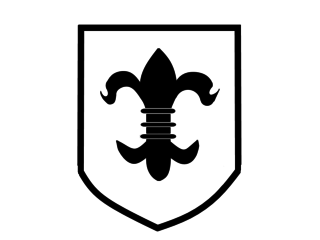
The 1st Infantry Division (1ID) is a combined arms division of the United States Army, and is the oldest continuously serving division in the Regular Army. It has seen continuous service since its organization in 1917 during World War I. It was officially nicknamed "The Big Red One" after its shoulder patch and is also nicknamed "The Fighting First." The division has also received troop monikers of "The Big Dead One" and "The Bloody First" as puns on the respective officially sanctioned nicknames. It is currently based at Fort Riley, Kansas.

The 84th Training Command ("Railsplitters") is a formation of the United States Army. During World War I it was designated the 84th Division, American Expeditionary Forces; during World War II it was known as the 84th Infantry Division. From 1946 to 1952, the division was a part of the United States Army Reserve as the 84th Airborne Division. In 1959, the division was reorganized and redesignated once more as the 84th Division. The division was headquartered in Milwaukee in command of over 4,100 soldiers divided into eight brigades—including an ROTC brigade—spread throughout seven states.

The 334th Infantry Division was a German Army infantry division in World War II. Originally formed in November 1942, it surrendered to the Allies at the conclusion of the Tunisian Campaign in May 1943. The division was reconstituted on 3 June 1943 in France within the 1st Army, with the staff of the 80th Infantry Division as well as remnants of the old division and replacement units. It spent the remainder of the war serving on the Italian Front.

The 246th InfantryDivision was a division of the German Wehrmacht during World War II. Towards the end of the war, it was redeployed under the name 246th Volksgrenadier Division.

The 75th Infantry Division was a German infantry division in World War II. It was formed on 26 August 1939.
The 144th Infantry Brigade was an infantry brigade of the British Army that saw active service in the First World War and again in the early stages of the Second World War before being reduced to a reserve brigade and remained in the United Kingdom for the rest of the war. In both world wars the brigade served with 48th Division.
The 159th Infantry Division was an infantry division of the German Heer during World War II. The unit, at times designated Commander of Reserve Troops IX, 159th Division, Division No. 159, and 159th Reserve Division, was active between 1939 and 1945.
The 160th Infantry Division was an infantry division of the German Heer during World War II. The unit, at times designated Commander of Reserve Troops X, Commander of Reserve Troops X/I, 160th Division, Division No. 160, and 160th Reserve Division, was active between 1939 and 1945.
The 166th Infantry Division was an infantry division of the German Heer during World War II. The unit, at times designated Commander of Reserve Troops 2 of Wehrkreis VI
The 168th Infantry Division was an infantry division of the German Heer during World War II. It was active between 1939 and 1945.
The 182nd Infantry Division was an infantry division of the German Heer during World War II. The unit, at times designated Commander of Reserve Troops XII/II, 182nd Division, Division No. 182, 182nd Replacement Division, Division Nancy,Division Gümbel, Division Karl, and 182nd Reserve Division, was active between 1939 and 1945.
The 190th Infantry Division, initially known as Division No. 190, was an infantry division of the German Heer during World War II.

The 198th Infantry Division was an infantry division of the German Heer during World War II.
The 252nd Infantry Division was an infantry division of the German Heer during World War II.
The 254th Infantry Division was an infantry division of the German Heer during World War II.
The 257th Infantry Division was an infantry division of the German Army during World War II.
The 260th Infantry Division was an infantry division of the German Heer during World War II.
The 298th Infantry Division was an infantry division of the German Heer during World War II.
The 304th Infantry Division was an infantry division of the German Heer during World War II. The 304th Infantry Division was deployed twice, once in November 1940 and once again in February 1945, after the destruction of the previous formation in January of that same year.
The 328th Infantry Division was the name of two distinct infantry divisions of the German army during World War II. The first, simply dubbed 328th Infantry Division, existed between 1941 and 1943, while the second, designated 328th Infantry Division "Zealand", existed for just under two months in 1945.






